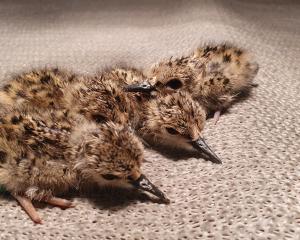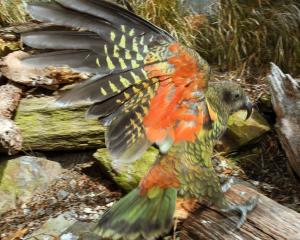Whitebaiting is fast becoming a must-do national pastime. But it is just as quickly facing a new, potentially disastrous, threat from an invasive water plant, writes Bruce Munro.
The second day of the whitebait season is only half spent and already Athol Matheson (78) is in his 'baiting rhythm.
Emerging from a caravan parked on a sweeping curve of the Taieri River, at Henley, the former Mosgiel engineer makes his two-hourly check of his whitebait net.
Lending a hand are his son Murray Matheson (44), grandson Nick Matheson (11) and Daisy the Labrador.
This catch yields hardly enough of the translucent, 55mm-long juvenile fish for a single patty. But Mr Matheson senior is unperturbed.
He will retire to his campsite, which is equipped with generator, flush toilet, television, microwave... ''everything I need'' to pleasantly while away a couple of hours until the next net check.
This will be his routine from dawn to dusk, seven days a week, until the conclusion of the whitebait season three months hence.
It is still early in the season and the river's clear water bodes well, he says.
Whitebait are unpredictable, but another bumper season like the past one would be welcome.
Last year, instead of his usual 50kg to 60kg season haul, Mr Matheson caught 130kg of whitebait. And that despite his ''stand'' being just one of about 25 within a 1km section of riverbank.
In part, he attributes the catch to the water quality on this stretch of the Taieri, which he says has been improving every year since the city council diverted Mosgiel's sewage from the river to the coastal outfall at Waldronville 13 years ago.
But you still have to be careful ''to look after the resource'', he says.
''Because if you don't, there won't be any whitebait left,'' his grandson chips in.
The fish spawn in the grass right the way along this river edge, Murray Matheson adds.
Unfortunately, he is mistaken.
Much of the brown grass he is pointing to is glyceria. And while the adult fish whose juveniles are called whitebait were probably laying eggs here as recently as a decade ago, the spread of this invasive plant means there are now no known whitebait spawning sites on the Taieri River.
It is a largely unrecognised threat, spreading quickly in front of the unseeing eyes of 'baiters, farmers and almost everyone.
Whitebaiting has a long history in New Zealand. Pre-colonial Maori caught the young fish using woven flax nets. Pakeha canned whitebait in the days before refrigeration.
They were once so plentiful that one of the five fish species collectively known as whitebait earned the nickname ''cow fish'' - they were so numerous the milt (semen) released by males fertilising the riverbank-spawned eggs turned the water a milky white.
The late-winter arrival of whitebait has long lured plenty of 'baiters with their dragnets or tapered set nets to set up camp on estuary riverbanks throughout New Zealand.
And it appears the practice is only growing in popularity, Pete Ravenscroft, who is an Otago-based Department of Conservation (Doc) freshwater ranger, says.
During Mr Ravenscroft's quarter-century of conservation work, he has seen a ''noticeable'' increase in the number of whitebaiters, ''especially in the past five years''.
This is confirmed by Otago sporting goods retailers.
Tristan Fraser, who is manager of Centrefire McCarthy's Stream and Field Store, said a steady increase in whitebait equipment sales in recent years suddenly jumped more than twofold last year.
Imports have halved the price of nets, encouraging more people to give it a go, Scott Kunac, who is owner of Allan Millar's Hunting and Fishing, says.
It seems whitebaiting is increasingly seen as an activity that represents New Zealand the way people want it to be, or wish it were - natural, accessible, active, healthy and not regulated to the eyeballs.
''I see a lot of families whitebaiting now,'' Mr Ravenscroft says.
''It's one of the few things you can do that doesn't cost you anything.
''It's become an iconic part of our country.''
But as their place in our national psyche deepens, whitebait themselves are becoming less plentiful.
Ivan Jones (73) says after more than six decades of whitebaiting, first at Waikouaiti and for the past 15 years at Taieri Mouth, catching 'bait is still ''always a buzz''.
The key to catching whitebait is ''being there'', Mr Jones says.
''You don't catch them sitting at home.''
And while he did have one day about four seasons ago when he netted 20kg in a few hours, nothing has come close to the enormous catch he took in the Waikouaiti River as a 12-year-old.
''I filled a muslin sock used for sides of meat. Then I filled a billy and then a bucket I found.''
That year a lot of whitebait was eaten by his family, plenty was given away, and the rest was fed to the chooks.
His experience echoes many others' - in recent decades, despite fluctuations, the overall quantity being caught has declined.
Four of the five species of galaxiids whose young are called whitebait - banded kokopu, giant kokopu, short-jawed kokopu and koaro - have been listed as threatened for some years. And the fifth, and most common species, the inanga, is now also listed as at risk.
Overfishing is not thought to be as large a problem as damage to spawning habitat. Loss of lowland wetlands, floodgates preventing migration, farm run-off degrading water quality, willows displacing spawning habitat and stock trampling spawning sites have all played their part, Mr Ravenscroft says.
But now whitebait are facing a new, quickly spreading threat that has caught everyone by surprise.
Glyceria, also known as mannagrass or sweet reed grass, is a robust perennial, aquatic plant that can infest large areas in a short time.
This exotic has waxy mid-green leaves and can form floating mats of roots and leaves that extend out into waterways. It displaces grasses on which whitebait lay eggs, but itself does not provide the right conditions for successful spawning, Ciaran Campbell (26), who is also a Doc Otago freshwater ranger, says.
Whitebait have a specific and ingenious method of spawning. Hatched larvae, which have spent the past 140 days at sea, return to estuaries as shoals of whitebait at this time of year, Mr Campbell says.
Those that grow to adult size during summer head downstream to spawn in tidal waters during March in most Otago rivers but as late as the end of May in the Clutha River.
''They wait for two days after a spring tide and then, two hours after the high tide, the females lay eggs on the riverbank vegetation which the males fertilise,'' Mr Campbell says.
The fish form in eggs which are above the waterline, safe but suitably damp in the thick vegetation where they were laid.
''Then, a month later, another full-moon tide triggers hatching and they swim out to sea as 7mm larvae to begin the cycle again.''
Glyceria, however, does not provide the matted vegetation needed to keep whitebait eggs damp. In fact, it traps silt, which tends to dry out the eggs.
And it is spreading, fast.
There is glyceria in both of the two major Doc Otago-administered rivers, the Clutha and the Taieri.
And Mr Ravenscroft is aware of it spreading in other New Zealand waterways, including in the North Island.
''We've known about it as an issue for five or 10 years but didn't perhaps fully appreciate its invasive nature,'' Mr Ravenscroft says.
''We've been caught a bit by surprise.''
Whereas in the 1990s whitebait were spawning at several sites along the Taieri River, Mr Ravenscroft has not found any evidence of spawning in that waterway during the past decade.
At the same time, glyceria has been eating up ever larger sections of the riverbank.
This week, Mr Ravenscroft was surprised to discover glyceria now growing on the banks of Titri Creek, a tributary of the Waipori River, which feeds into the Taieri River.
Doc has had a statutory responsibility for whitebait management since the department's inception in 1987.
There was a national drive to identify and record spawning habitat in the 1990s, Mr Ravenscroft said.
Since then, although good gains have been made in some regions such as Otago, the West Coast and Hawkes Bay, habitat protection and improvement has not been consistent nationwide.
In Otago, with the co-operation of Contact Energy on the Clutha River and of landowners on the Clutha, Taieri, Waikouaiti, Tokomairiro, Kakanui and Shag rivers and in the Waihola-Waipori wetlands, the department has been restoring spawning habitat.
Mr Ravenscroft says he has never had a farmer refuse to help protect whitebait spawning sites.
''For some reason, if you're talking about whitebait, it's not a problem; there's total support,'' he says.
''I think that's because whitebaiting is about who we are. And if we want to maintain it for future generations, people realise we need to manage it now.''
Last year, Mr Ravenscroft was able to tell Clutha River whitebaiters that for the first time in many years, a spawning site had been found on their river.
Even so, he says whitebait are ''struggling'' and glyceria is now their biggest threat on Otago's two major rivers.
Jane Goodman (34), who is Doc's national freshwater technical adviser, says the department does not have a national whitebait plan but a review has begun that will decide whether one is needed.
That review could include considering what response to glyceria is needed, Hamilton-based Miss Goodman says.
Mr Ravenscroft says spraying of glyceria, in partnership with the Otago Regional Council, has begun on the Clutha River. It will, it is hoped, begin on the Taieri River before the end of the year.
Because glyceria is spread by its seeds and by sections of the plant breaking off and floating to new sites, it cannot be removed from previous spawning habitats alone.
''We need to look at total removal from the catchment,'' he says.
''It will require significant effort, and the effort needs to be ongoing.''
There has been lots of debate and recrimination about the state of New Zealand's waterways in recent years.
But now, for the sake of the likes of whitebait and future generations of whitebaiters, it is time for a different approach, Mr Ravenscroft says.
''It's time to stop blaming different industries and agencies ... The arguments have been had.
"We need to put it aside and work together to protect what we've got left.''




